(MENAFN- Asia Times) Sooner or later Myanmar's military was bound to wheel out the big guns. Since March, when peaceful protest against the February 1 coup turned to armed resistance, the generals in Naypyidaw have watched too much go too wrong in too many places for too long.
In the nation's ethnic Bamar heartland so-called“people's defense forces” (PDFs) have proliferated to challenge military authority; from the borders of China and Thailand ethnic armies have extended them sanctuary, training, and weapons; and in strategically vital regions of Myanmar's west and east bomb blasts and killings have escalated into full-blown insurgency.
Against this backdrop, a September 7 declaration of a“people's defensive war” by an opposition shadow administration, the National Unity Government (NUG), merely acted as a brazen accelerant to a spreading fire.
Time to spread out the maps in army headquarters for Operation Anawrahta, the Tatmadaw's first full-bore campaign to restoring a semblance of order in a nation veering ever closer to – depending on your perspective – anarchic disintegration or a social revolution to break the military's decades-long stranglehold on Myanmar's national life.
Operation Anawrahta
The scale and geographical breadth of the impending campaign is striking, indeed arguably unprecedented even in the annals of an army that has been fighting non-stop since Independence in 1948.
In contrast to annual forays launched against troublesome ethnic minorities in the nation's rugged borderlands or earlier sweeps against pockets of communist insurrection in the Irrawaddy Delta and Bago Yoma hills, Operation Anawrahta reflects both a different dynamic and far higher stakes: for the first time the Tatmadaw is seeking to reassert a strategic dominance long taken for granted but which week by week through mid-2021 has been slipping away, most alarmingly in the west.
Almost certainly not by coincidence, the impending big push has been named in honor the warrior-founder of the Burmese nation who ascended the throne of Pagan in 1014 and unified a state around the very same Irrawaddy valley heartland now in turmoil.
Opening in earnest in late October or early November as soon as monsoon-soaked ground has dried out, Operation Anawrahta will almost certainly not be launched as a D-Day exercise in“shock and awe.”
Playing to the army's strengths and allowing for flexible redeployments of troops, a more likely course of action is a rolling series of separate but interlocking offensives that will extend into the New Year and the scorching heat of central Myanmar's dry season.
Preparations for an extended campaign have been under way since at least September. With little fanfare, infantry battalions, mechanized units, artillery pieces and armored vehicles have been readied in forward operating bases – Pakokku, Monywa and Kalay – across a wide and strategically critical arc of western Myanmar that lies between ethnic insurgent strongholds in Kachin state in the north and Rakhine state on the Bay of Bengal in the southwest.
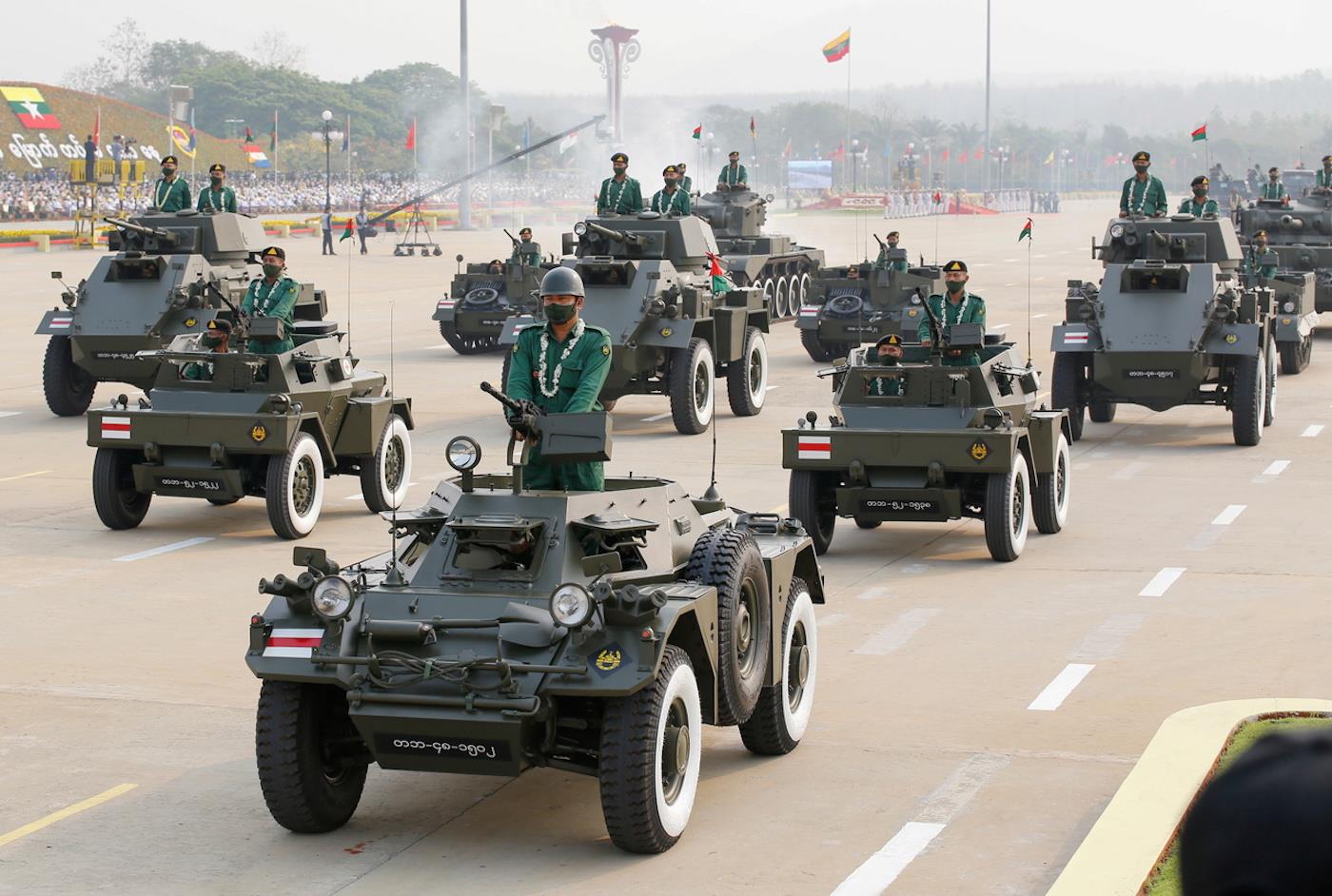
Myanmar's Tatmadaw in an Armed Forces Day parade in Naypyitaw, March 27, 2021. Photo: Agencies
Beginning in September, an ominous shut-down of internet connections and occasionally even phone lines has been imposed across some 25 western townships in the army's cross-hairs. A measure tested for months during hostilities in Rakhine state in 2019 and 2020, the communications black-out will both complicate coordination of PDF counterattacks and pre-empt social and mainstream media reporting of the excesses that typically accompany Tatmadaw operations.
Planning has undoubtedly been driven into higher gear following the abrupt departure of the Sagaing-based Northwestern regional commander Brigadier General Phyo Thant. Detained in early October amid rumors of disloyalty and after presiding over daily humiliations of the military by ill-armed PDF fighters, the disgraced commander reportedly remains under house arrest.
Replacing him are two more senior generals, both noted hardliners, who from Naypyidaw and Sagaing will ensure close oversight of the campaign and the performance of its field commanders.
One is Lieutenant General Than Hlaing, deputy interior minister and head of Myanmar's increasingly militarized police force; the other, Lieutenant General Tayza Kyaw, is head of Bureau of Special Operations No 1, which coordinates operations involving regional commands across the north of the country.
Tatmadaw 'elite'
The number of forces at the disposal of the two generals and their staff is difficult to gauge and almost certain to vary depending on tactical requirements.
But based on the number of centrally and regionally commanded formations already deployed into the western theater – historically a military backwater with virtually no insurgent activity – a reasonable estimate would suggest a build-up of some 30,000 troops from a Tatmadaw base-line infantry combat strength that is unlikely to number much more than 100,000 -120,000 men.
Predictably, a significant proportion of Naypyidaw's praetorian force of ten centrally commanded Light Infantry Divisions (LIDs) will be at the sharp end of offensives. Already four divisions (or substantial elements of them) have been deployed into the western theater.
Often described in western media as“elite” units, LIDs play a role on the battlefields of Myanmar that is a long way from that of highly trained and well-equipped special forces such as Britain's Special Air Service (SAS) or Russia's Spetsnaz, typically associated with term“elite” in advanced militaries.
Divided into mobile Tactical Operations Commands (TOCs) of three battalions with attached artillery and access to close air support when required, LIDs are essentially assault troops, once invariably infantrymen, today increasingly mechanized. They constitute a cohesive, experienced, ruthless and, not least, unswervingly loyal army-within-an-army. Think Saddam Hussein's Republican Guard – only“lite.”
Those qualities and the esprit de corps that goes with them set the LIDs sharply apart from line battalions commanded by the army's Regional Military Commands (RMCs), troops whose training, discipline, and morale typically leave much to be desired. In the coming months, those liabilities will inevitably face growing strains.
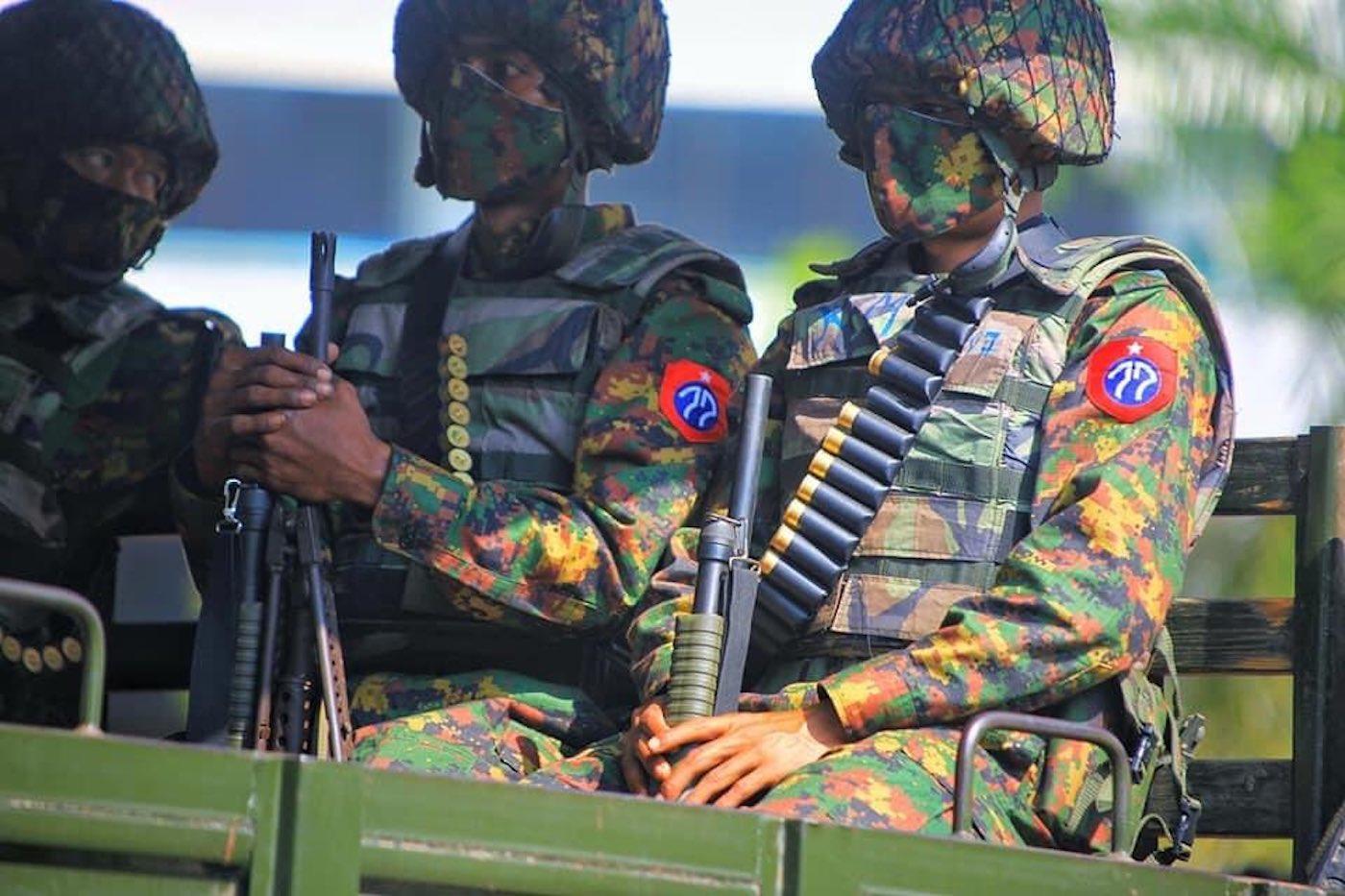
Soldiers from the 77th Light Infantry Division. Photo: YouTube screengrab
In addition to army troops, the coming campaign will also rely importantly on air force helicopters and ground attack jets, naval riverine patrol vessels and landing craft. On paper at least, it will unfold as a series of combined-arms operations of the sort practiced by the Tatmadaw in carefully choreographed bi-annual exercises played out amid a saturation media coverage on the army training grounds outside the central city of Meiktila.
Only now the geography will be far more varied and dauntingly wider. Over the coming weeks and months, offensives will target PDFs in four more or less distinct operational theaters.
Zones of operation
Arguably the two most important are northern Chin state and northeast Sagaing Region, both zones where long-standing ethnic armed groups have been willing to extend training, weapons and operational support to newly emerging and increasingly aggressive PDFs.
Not by coincidence, in recent weeks locations in both areas have been targeted by airstrikes as Tatmadaw ground forces have struggled to deal with resistance attacks.
In north Chin the Chin National Army (CNA), while small and militarily inactive in recent years, has retained a core of trained personnel and been willing to open its Camp Victoria headquarters in Thantlang township on the Indian border to hundreds of PDF volunteers. It is also likely that the CNA has cross-border connections that facilitate the smuggling of munitions from the Indian states of Mizoram and Manipur.
PDFs in northeast Sagaing, meanwhile, have benefitted from supplies from, and joint operations with units of the 9th Brigade of the Kachin Independence Army (KIA). Moving south from Mohnyin in Kachin state via Indaw and Katha these forces have infiltrated the neighboring Bamar-inhabited townships of Pinlebu, Wuntho, Kawlin and Tigyaing, providing local PDFs material and psychological support.
Two other areas likely to see major operations in the coming month are north Magway Region and adjacent south Sagaing, both of which have emerged since mid-year as zones of persistent PDF activity and already been repeatedly targeted – to little obvious effect – by Tatmadaw and police raiding parties.
In north Magway, the Tatmadaw's forward operating base will be the garrison town of Pakokku on the Irrawaddy River, a major military cantonment and home of the 101st LID. Beyond the township of Pauk where PDF attacks have been common, the main target is likely to be three adjacent townships of Gangaw, Tilin and Saw that share the Yaw dialect of Burmese and have established a single Yaw Defense Force (YDF).
Worryingly for army planners, the Bamar YDF has already established ties with the ethnic Chin Chinland Defense Force (CDF) in the Mindat- Kanpetlet area just across the Chin state border.
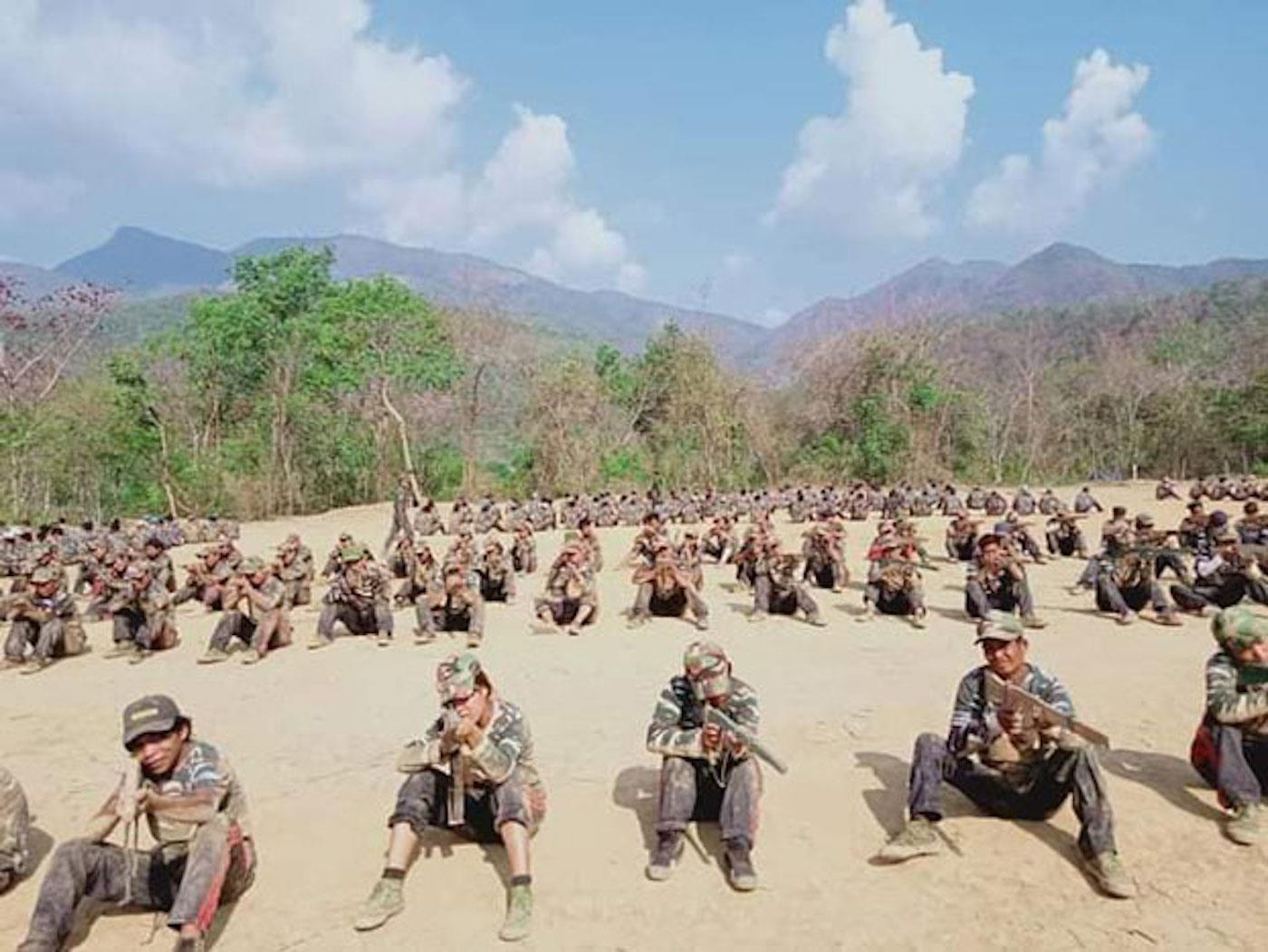
Chinland Defense Forces in a training session. Photo: Facebook
Geographically contiguous to north Magway, south Sagaing comprises a wide swath of farming country spread along the valley of the Chindwin River, which flows from the Indian border to its confluence with the Irrawaddy.
A long-time bastion of Aung San Suu Kyi's Nation League for Democracy, the region is largely open terrain conducive to rapid security force movements, a factor which appears to have inhibited both the formation of larger PDFs and effective collaboration across township boundaries.
Even so, PDFs in several townships, most notably Mingin, Kani and Pale, have mounted often aggressive resistance and can expect to be hit hard.
Clearance operations
The scope and shape of offensives will be conditioned by terrain and assessments of opposition, but will probably hinge mostly on major“clearance operations.” Typically involving infantry backed by armored units, these sweeps will be aimed primarily at flushing out centers of PDF resistance, pinning them down and then bringing to bear superior firepower.
Among the few easily identified static targets will be the CNA's Camp Victoria, an important training facility and organizational hub.
But situated as it is on the Indian border, any attempt to overrun the base will risk artillery shells and airstrikes, not to mention thousands of refugees, spilling into Indian territory potentially antagonizing a neighbor who to date has been generally sympathetic to the coup regime and its efforts to“stabilize” the country.
Unavoidably,“clearance operations” will involve sweeps through villages searching for arms caches and PDF supporters with civilians being either rounded up for interrogation or driven into nearby countryside. This scenario will repeat on a far larger and more systematic scale the raids on villages that have already played out in Magway and Sagaing and on more than one occasion been accompanied by reports of summary massacres.
Far less easy to predict is the extent to which PDFs will attempt to resist these offensives or will succeed in avoiding major confrontations with advancing Tatmadaw forces to reemerge later to conduct guerrilla attacks on exposed communication and supply lines.
Lack of experience and leadership may encourage quixotic and costly resistance, particularly in situations where civilians and families are at immediate risk. Complicating a militarily smarter guerrilla response will be a serious shortage of support weaponry, in particular machine guns, rocket-propelled grenades and mortars.
The likelihood is that both reactions will be in evidence in different situations to produce a confused and bloody melee largely cut off from communications with the outside world.
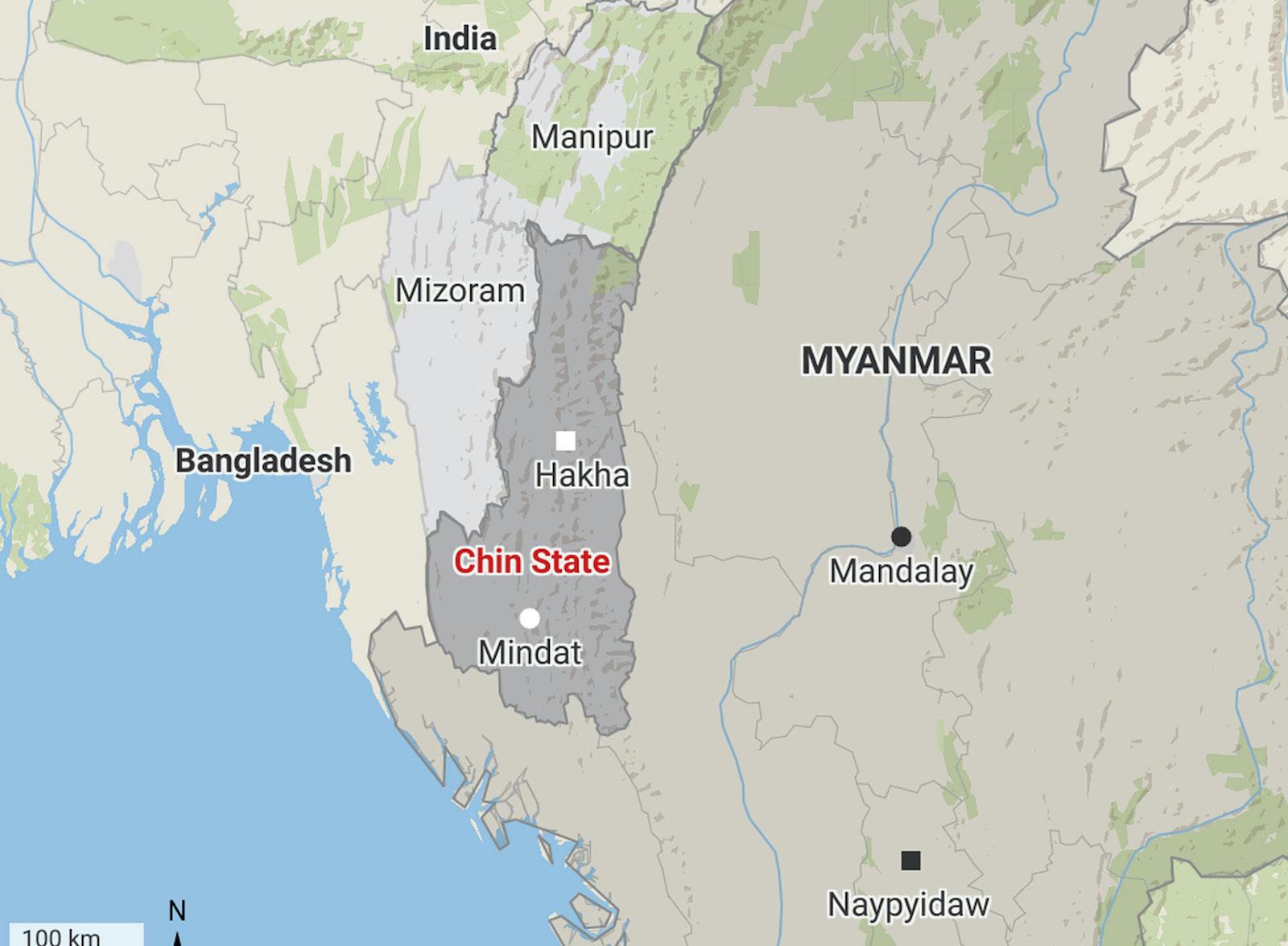
Resistance forces in Myanmar's Chin state are in the Tatmadaw's crosshairs. Map: Twitter
None of that, however, will mitigate the Tatmadaw's fundamental dilemma: a shortage of manpower that, once the heavy firing dies down, will impose real strains on the army's ability to control conquered territory and permit resistance forces to recover, regroup and hit back.
This perennial conundrum of counterinsurgency typically drives two very different responses, and in western Myanmar in the coming months it is again likely that a confused mixture of both will emerge from the smoke of conflict.
One reaction may see the Tatmadaw attempting to maintain a spread of forces across village tracts where in certain townships PDFs have been notably active. But the dispersal of forces required for a counterinsurgency grid dominating rural hinterlands will leave outposts and supply transport vulnerable to the sort of daily harassment using IEDs that between July and September already cost hundreds of security force casualties.
Four cuts and three all's
The alternative would be for the military to revert to more drastic measures: depopulating entire rebel-leaning villages.
There was an era when the strategy of relocating rural populations into defensible settlements and severing links between civilians and rebels had a place in Tatmadaw counterinsurgency manuals.
Known in Myanmar as the“four cuts”, the theory was introduced in the 1960s by Western military advisors – most notably Colonel Ted Serong of the Australian Army — and drew on Cold War counterinsurgency practice in Malaya and later South Vietnam.
The method aimed at cutting off insurgents from the four essentials of food, funding, recruits and intelligence, while bringing the benefits of enlightened governance to a relocated rural population securely wired off from communist subversion.
In colonial Malaya of the 1950s, the resettlement of communist-leaning Chinese squatter populations known as the“New Village program” was a broad success – at least for the British military. The attempt to replicate it in the very different social and political context of Ngo Dinh Diem's South Vietnam was a spectacular failure.
In Burma of the 1960s, a lack of resources meant the“four cuts” as an element of the anti-communist campaign was never prioritized sufficiently to be strategically relevant. Before long it was also pushed aside by a far blunter and essentially Burmese approach to counterinsurgency, particularly as practiced by the Tatmadaw's Bamar soldiery in remote border regions inhabited by what many of them saw as culturally“inferior” ethnic minorities.
This was a brand of counterinsurgency that had nothing to do with Western theories underpinning the“four cuts” but much in common with the“three all's” of the Japanese Imperial Army in China of the 1940s – burn all, kill all, loot all. And in the Myanmar context, scorched earth methods could be usefully supplemented by driving hundreds of thousands across international borders into Thailand, China, Bangladesh and now India.
As smoke already rising from villages across western Myanmar clearly illustrates, even in ethnic Bamar regions Tatmadaw operational practice continues to draw heavily on the“three all's”, leaving the“four cuts” mainly to the realm of loose media commentary.
And in the coming months, the rural populations fleeing from more burning villages will almost certainly not benefit from either“new villages” or even“strategic hamlets”: the Tatmadaw has neither the resources nor the mentality to“manage” counterinsurgency.
Collateral damage
The result will probably be a mushrooming of squalid refugee camps in township and regional centers that will both serve as new hearths of resistance and exacerbate a humanitarian disaster the military's State Administration Council is already incapable of addressing.
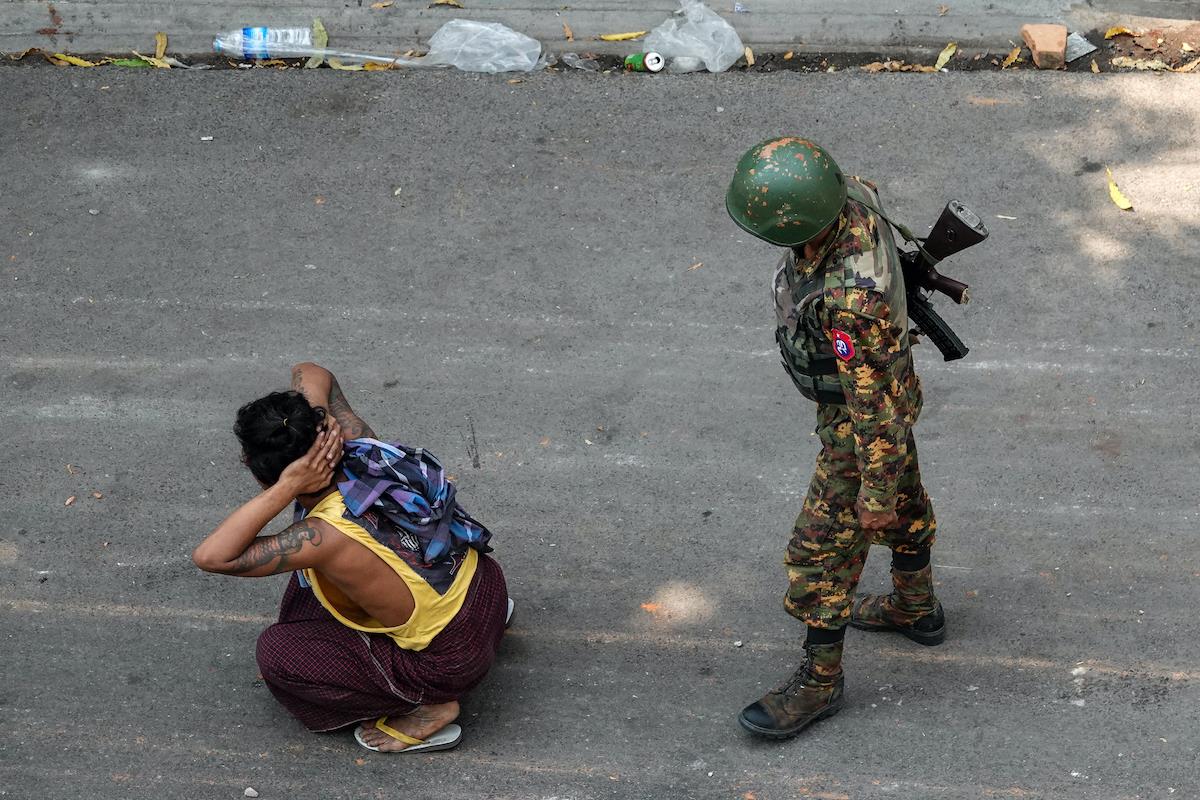
A soldier next to a detained man during a demonstration against the military coup in Mandalay on March 3, 2021. Photo: AFP
It is doubtful whether those planning Operation Anawrahta have given much thought to the collateral damage their offensives will cause and the multiplier effect that this will have on popular resistance. At one level, they have never needed to in the past; at another, they have already turned their backs on alternative options.
But perhaps an even more important element of collateral damage in the months to come will be the impact on army rank-and-file and junior officers as they contemplate what their commanders have led them to inflict on their own countrymen.
In the short term, the Tatmadaw ethos of iron discipline will serve to insulate the soldiers from their actions. But as weeks turn to months and the civilian body-count mounts, corrosive demoralization among many of their own forces may prove a far greater threat to the generals in Naypyidaw than the meager military capabilities of the resistance they are now gearing up to crush.
MENAFN20102021000159011032ID1103001330